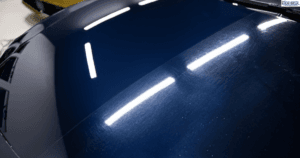If you’ve invested in paint protection film (PPF) for your vehicle, you’re already aware of the benefits of protection from scratches, UV rays, and environmental contaminants. But knowing how to wash and maintain a car with PPF is just as important as the initial installation.
This guide will tell you the steps to properly clean your car’s paint protection film and ensure it stays looking brand new.
Understanding Paint Protection Film
Before diving into the washing process, let’s quickly recap what paint protection film is and why it’s important. PPF is a transparent, durable film applied to your car’s surface to protect the paint from damage caused by road dirt, scratches, and harsh weather conditions.
Many car lovers and professionals who have undergone PPF training know that keeping this film clean is vital for its longevity and appearance.
Read More: How Much to Tip a Car Detailer
Steps to Wash a Car with Paint Protection Film

Maintaining your PPF doesn’t require complex tools or chemicals. However, there are certain precautions you should take to avoid damaging the film.
1. Use a Gentle Car Wash Soap
Always opt for a pH-balanced car wash soap when cleaning a car with PPF. Regular household detergents or harsh chemicals can damage the film’s protective layer over time. A gentle soap ensures the film remains intact while effectively removing dirt and grime.
Professionals who have gone through PPF training classes from us will recommend using a foam cannon or microfiber wash mitt for an even and thorough cleaning process. Both of these tools are safe for the PPF surface and won’t cause unnecessary scratches.
2. Avoid High-Pressure Washers
While high pressure washers can make car washing quicker, they can potentially lift or damage the edges of your paint protection film. If you must use a pressure washer, keep the nozzle at least 2-3 feet away from the surface of the car and avoid spraying directly at the edges of the film.
Those who have taken training classes are often taught the proper techniques for maintaining PPF during a wash, including how to avoid direct pressure that can peel the film off.
3. Wash in the Shade
Direct sunlight can cause water spots to form on your car’s surface, especially on PPF. It’s best to wash your car in the shade or during the cooler parts of the day, such as early morning or late afternoon. This prevents water from drying too quickly on the surface, allowing for a smooth, spotless finish.
4. Use the Two-Bucket Method
This tried-and-true method is highly recommended for cars with paint protection film. The two bucket method uses one bucket for soapy water and another for rinsing your mitt. This reduces the chance of dirt scratching the PPF during the washing process.
Professionals certified in paint protection film installation training & certification often emphasize this technique to prevent even the smallest scratches.
5. Dry with a Microfiber Towel
After washing, use a high-quality microfiber towel to dry the vehicle. Unlike cotton towels, microfiber towels are soft and gentle, preventing the formation of swirl marks or scratches on the PPF. Avoid air-drying your car as it can leave behind water spots, which can be difficult to remove from paint protection film.
Read More: How Long Does It Take to Detail a Car?
How to Clean Paint Protection Film

Aside from regular washing, your PPF may require occasional deep cleaning to remove stubborn contaminants such as bird droppings, tree sap, or road tar. Here’s how you can safely clean your paint protection film:
1. Spot Clean with a Detailing Spray
For small areas stuck on dirt, use a detailing spray that’s safe for PPF. Simply spray the product on the affected area and gently wipe it off with a microfiber cloth. Avoid using abrasive materials, as these can scratch the surface of the film.
2. Use a Clay Bar for Deep Contaminants
If your paint protection film has become contaminated with tar, tree sap, or other substances, a clay bar is a great solution. Lubricate the area with a clay bar lubricant and gently glide the clay bar across the surface. This will lift off contaminants without scratching the film.
Our PPF training classes often include advanced techniques like using a clay bar or specialized cleaning products to maintain paint protection films. It’s a skill that professionals learn through extensive hands-on experience.
3. Avoid Harsh Chemicals
While paint protection film is highly durable, it’s still susceptible to damage from harsh chemicals. Always avoid cleaners with alcohol, ammonia, or any abrasive compounds that could break down the protective layer of the film. Stick to products specifically designed for PPF.
Read More: How Much Does It Cost to Wrap a Car?
Why Paint Protection Film Maintenance Matters

Maintaining your paint protection film ensures that your car stays looking its best and that the film continues to do its job of protecting your vehicle’s paintwork. Regular washing and cleaning extend the life of the film and prevent costly repairs or replacements. Moreover, certified professionals who have done paint protection film training can offer expert services that help keep your vehicle fresh.
At Monster Detailing School, we offer comprehensive PPF training classes designed to teach you everything you need to know about PPF installation and maintenance.
Whether you’re a car lover looking to maintain your vehicle or a professional aiming to expand your services, our paint protection film installation training & certification will provide you with the skills needed to excel in this growing industry.
Conclusion
Washing and maintaining a car with paint protection film is not difficult, but it does require some care and attention to detail. By following the steps outlined in this guide, you can keep your PPF in great condition, ensuring that your vehicle remains protected and looking its best for years to come.
Take the next step in your car detailing journey with car detailing training from Monster Detailing School!










